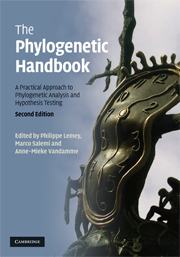Book contents
- Frontmatter
- Contents
- List of contributors
- Foreword
- Preface
- Section I Introduction
- Section II Data preparation
- Section III Phylogenetic inference
- 4 Genetic distances and nucleotide substitution models
- 5 Phylogenetic inference based on distance methods
- 6 Phylogenetic inference using maximum likelihood methods
- 7 Bayesian phylogenetic analysis using MRBAYES
- 8 Phylogeny inference based on parsimony and other methods using PAUP
- 9 Phylogenetic analysis using protein sequences
- Section IV Testing models and trees
- Section V Molecular adaptation
- Section VI Recombination
- Section VII Population genetics
- Section VIII Additional topics
- Glossary
- References
- Index
4 - Genetic distances and nucleotide substitution models
from Section III - Phylogenetic inference
Published online by Cambridge University Press: 05 June 2012
- Frontmatter
- Contents
- List of contributors
- Foreword
- Preface
- Section I Introduction
- Section II Data preparation
- Section III Phylogenetic inference
- 4 Genetic distances and nucleotide substitution models
- 5 Phylogenetic inference based on distance methods
- 6 Phylogenetic inference using maximum likelihood methods
- 7 Bayesian phylogenetic analysis using MRBAYES
- 8 Phylogeny inference based on parsimony and other methods using PAUP
- 9 Phylogenetic analysis using protein sequences
- Section IV Testing models and trees
- Section V Molecular adaptation
- Section VI Recombination
- Section VII Population genetics
- Section VIII Additional topics
- Glossary
- References
- Index
Summary
THEORY
Introduction
One of the first steps in the analysis of aligned nucleotide or amino acid sequences typically is the computation of the matrix of genetic distances (or evolutionary distances) between all pairs of sequences. In the present chapter we discuss two questions that arise in this context. First, what is a reasonable definition of a genetic distance, and second, how to estimate it using statistical models of the substitution process.
It is well known that a variety of evolutionary forces act on DNA sequences (see Chapter 1). As a result, sequences change in the course of time. Therefore, any two sequences derived from a common ancestor that evolve independently of each other eventually diverge (see Fig. 4.1). A measure of this divergence is called a genetic distance. Not surprisingly, this quantity plays an important role in many aspects of sequence analysis. First, by definition it provides a measure of the similarity between sequences. Second, if a molecular clock is assumed (see Chapter 11), then the genetic distance is linearly proportional to the time elapsed. Third, for sequences related by an evolutionary tree, the branch lengths represent the distance between the nodes (sequences) in the tree. Therefore, if the exact amount of sequence divergence between all pairs of sequences from a set of n sequences is known, the genetic distance provides a basis to infer the evolutionary tree relating the sequences.
- Type
- Chapter
- Information
- The Phylogenetic HandbookA Practical Approach to Phylogenetic Analysis and Hypothesis Testing, pp. 111 - 141Publisher: Cambridge University PressPrint publication year: 2009
- 19
- Cited by

